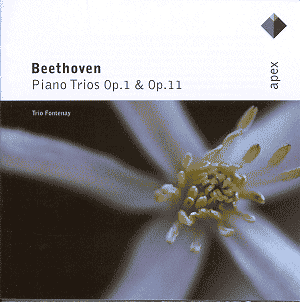Beethoven
composed eleven numbered trios for the combination of piano, violin
and cello. The first three piano trios Opus 1 were published in
1795 and were composed a few years earlier. Contained on this
Apex disc, which was originally released on Teldec, are the first
two of the Opus 1 set: No.1 in E flat major and No.2 in G major.
In addition the piano trio No.4 in B flat major ’Gassenhauertrio’
is included.
The
piano trios Nos. 1 in E flat major and 2 in G major are in the
four movements, each containing a Scherzo and were fairly
early examples of the piano trio form. Beethoven gives fairly
equal treatment to each of the instruments, with the cello ceasing
to be merely used as mere basso continuo accompaniment,
giving notice of the composer’s move from the world of fashionable
salon music.
The
third and final piano trio on this release is the No.4 in B flat
major Op. 11 which dates from 1798. Composed in three movements
this work is a good example of how Beethoven was still using the
piano trio in a lighter form as opposed to the more serious medium
of the string quartet. For example, in this piano trio Beethoven
uses in the concluding movement nine variations on a theme from
Joseph Weigl’s opera buffa L’amor marinaro (Maritime Love).
Consequently the trio is sometimes known as the ’Gassenhauertrio’
meaning popular hit.
The
Hamburg-based Trio Fontenay offer pleasing if rather swift performances
in all three of these piano trios. However, I feel that they cannot
compete with my favoured version of these works from the Beaux
Arts Trio in their 5 CD set of the complete piano trios on Philips
468 411-2. As the timings, in three of the movements, were very
different between the two sets of performers I made investigations
and discovered that the Trio Fontenay have decided to omit the
exposition repeats that the Beaux Arts Trio retain.
Overall
the Beaux Arts Trio are more convincing with a greater depth to
their interpretations, displaying a real sense of music making.
In the E flat major trio Beaux Arts perform the Adagio cantabile
with a remarkable serenity for which I must single out the
marvellous playing of violinist Isidore Cohen. Furthermore, there
is a heightened expression for the romantic mood of the lyrical
Largo con espressione of the G major trio and they offer
more spontaneity and verve in both Scherzo movements.
In
the B flat major work the Trio Fontenay play with pace, sensitivity
and control without ever matching the Beaux Arts who display that
innate facility of insight, offering real grace and feeling in
the Adagio. In the charming final movement variations the
Beaux Arts have that extra element of lyricism and sense of real
engagement, where the playing from master pianist Menahem Pressler
is sublime.
The
Apex recording, originally published in 1993, has an acceptable
sound yet somehow doesn’t have the clarity and detail of the earlier
Beaux Arts set. Although the Beaux Arts performances of these
trios were recorded back in 1981 there is certainly no sign of
their age and the Philips packaging is excellent too. It is a
shame that Apex do not find it necessary to provide any information
whatsoever about the Trio Fontenay. It would have proved most
useful.
Well
played performances from the Trio Fontenay but they cannot compete
with the top-of-the-range competition from the Beaux Arts Trio
who impart far more depth and insight.
Michael
Cookson
